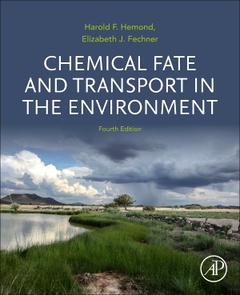Description
Chemical Fate and Transport in the Environment (4th Ed.)
Authors: Hemond Harold F., Fechner Elizabeth J.
Language: English
Subject for Chemical Fate and Transport in the Environment:
93.83 €
In Print (Delivery period: 14 days).
Add to cart520 p. · 19x23.4 cm · Paperback
Description
/li>Contents
/li>Biography
/li>Comment
/li>
Chemical Fate and Transport in the Environment, Fourth Edition explains the fundamental principles of mass transport, chemical partitioning, and chemical/biological transformations of pollutants and naturally occurring chemicals in surface waters, in the subsurface (which includes soil and groundwater), and in the atmosphere. Each of these three major environmental media is introduced by a descriptive overview, followed by presentations of the governing physical, chemical, and biological processes. The text emphasizes intuitively based mathematical models for chemical equilibria, transformations, and transport in the environment. This book serves as a primary text for graduate and senior undergraduate courses in environmental science and engineering, provides relevant scientific knowledge for students of public health and environmental policy, and is a useful reference for environmental practitioners.
This fourth edition builds on the third edition, which won a 2015 Textbook Excellence Award (Texty) from The Text and Academic Authors Association. This updated textbook expands the discussion of global climate change, presents concepts of stationarity and sustainability, provides additional coverage of wastewater treatment and air pollution abatement technologies, and includes information on additional anthropogenic pollutants such as plastics, PFAS, and nanoparticles. Tables, figures, and references are updated, and worked examples and practice exercises are included for each chapter.
1. Basic Concepts 2. Surface Waters 3. The Subsurface Environment 4. The Atmosphere
Appendix A. Dimensions and Units for Environmental Quantities B. Models for Chemical Equilibrium, Surface Waters, Groundwater, the Atmosphere, and Global Climate
Elizabeth Fechner was a teaching assistant for the MIT course on which this book is based. She has worked for several environmental consulting firms, performing fate and transport analyses for private clients and the U.S. Environmental Protection Agency. She has also provided technical support to attorneys in cases of environmental litigation.
- Illustrates the interconnections, similarities, and contrasts among three major environmental media: surface waters, the subsurface (which includes soil and groundwater), and the atmosphere
- Discusses and builds upon fundamental concepts, teaching students to realistically address environmental problems and preparing students for more advanced studies
- Each chapter includes many worked examples and extensive practice exercises; a solutions manual is available for instructors
These books may interest you

Soil and Water Contamination 220.72 €

Soil and Water Contamination 123.78 €


